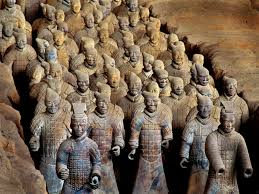
The Terracotta Army
Introduction
The Terracotta Army is a collection of terracotta sculptures depicting the armies of Qin Shi Huang, the first emperor of China. It is a form of funerary art buried with the emperor in 210–209 BCE with the purpose of protecting the emperor in his afterlife.
The figures, dating from approximately the late third century BCE,[1] were discovered in 1974 by local farmers in Lintong County, outside Xi'an, Shaanxi province, China. The figures vary in height according to their roles, with the tallest being the generals. The figures include warriors, chariots and horses. Estimates from 2007 were that the three pits containing the Terracotta Army held more than 8,000 soldiers, 130 chariots with 520 horses, and 150 cavalry horses, the majority of which remained buried in the pits near Qin Shi Huang's mausoleum.[2] Other terracotta non-military figures were found in other pits, including officials, acrobats, strongmen, and musicians.[3]
History
Construction of the Mausoleum
Map of Qin Shi Huang's Mausoleum complex and the location of the Terracotta Army ( ). The central tomb itself remains unexcavated.[4]
The construction of Qin Shi Huang's mausoleum is described by historian Sima Qian (145–90 BCE) in the Shiji, the first of China's 24 dynastic histories, which was written a century after the mausoleum's completion. Work on the mausoleum began in 246 BCE soon after Emperor Qin (then aged 13) ascended to the throne, and eventually involved the work of over 700,000 conscripted laborers.[5][6] Geographer Li Daoyuan, writing six centuries after the First Emperor's death, noted in his commentary on the Shui Jing Zhu that Mount Li was a favored location for a tomb because of its auspicious geology: "famed for its jade mines, its northern side was rich with gold, while its southern side abounded in beautiful jade; the First Emperor, covetous of its fine reputation, therefore chose to be buried there".[7][8]
Sima Qian wrote that within the tomb's mound were palaces, towers, officials, valuable artifacts and wondrous objects. According to this account, 100 flowing rivers were simulated using mercury, and above them, the ceiling was decorated with heavenly bodies, below which were the features of the land.[9] Some translations of this passage mention "models" or "imitations"; however, those words were not used in the original text, which makes no mention of the terracotta figures.[5] While Sima Qian's account of the inner structure of the tomb was considered credible in pre-modern assessments, the discovery of the site revealed that high levels of mercury were present in the tomb mound, making this claim more credible.[10] It is also well documented that the emperor had created a vast collection of human statues during his reign, such as the Twelve Metal Colossi, a series of statues which have been lost but were documented in historical records.[11]
Later History
Later historical texts mention that the tomb complex was subjected to vandalism by Xiang Yu, a contender to the throne after the First Emperor's death.[12][13][14] However, there are indications that the tomb itself may not have been looted.[15]
FAQs
What is the purpose of the Terracotta Army?
The Terracotta Army was created to protect Qin Shi Huang, the first emperor of China, in his afterlife.
When was the Terracotta Army discovered?
The Terracotta Army was discovered in 1974 by local farmers.
Where is the Terracotta Army located?
The Terracotta Army is located in Lintong County, outside Xi'an, Shaanxi province, China.